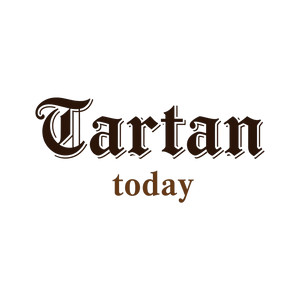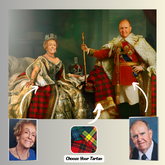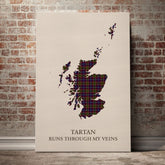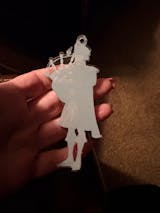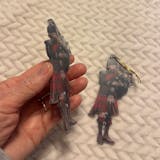-
Personalized Clan Aikenhead Tartan Bagpipe Ornament with Custom Name – Scottish Christmas Tree Decoration NU96
Personalized Clan Aikenhead Tartan Bagpipe Ornament with Custom Name – Scottish Christmas Tree Decoration NU96Celebrate your Scottish heritage with this unique wood & acrylic tartan ornament. Perfect as a personalized Christmas decoration or a meaningful gift for friends and relatives on special occasions such...- From $19.99 USD
$25.99 USD- From $19.99 USD
- Unit price
- per
Save $6.00 -
Personalized Clan Aikenhead Tartan Drummer Ornament with Custom Name – Scottish Christmas Tree Decoration MX61
Personalized Clan Aikenhead Tartan Drummer Ornament with Custom Name – Scottish Christmas Tree Decoration MX61Celebrate your Scottish heritage with this unique wood & acrylic tartan ornament. Perfect as a personalized Christmas decoration or a meaningful gift for friends and relatives on special occasions such...- From $19.99 USD
$25.99 USD- From $19.99 USD
- Unit price
- per
Save $6.00 -
Personalized Clan Aikenhead Tartan Bagpipe Ornament with Custom Name – Scottish Christmas Tree Decoration UX58
Personalized Clan Aikenhead Tartan Bagpipe Ornament with Custom Name – Scottish Christmas Tree Decoration UX58Celebrate your Scottish heritage with this unique wood & acrylic tartan ornament. Perfect as a personalized Christmas decoration or a meaningful gift for friends and relatives on special occasions such...- From $19.99 USD
$25.99 USD- From $19.99 USD
- Unit price
- per
Save $6.00 -
Personalized Clan Aikenhead Clan Crest Tartan Santa Ornament – Custom Acrylic Christmas Decoration OZ82 - Aikenhead
Personalized Clan Aikenhead Clan Badge Tartan Ornament – Custom Acrylic Christmas Decoration OZ82Celebrate your Scottish heritage with this unique wood & acrylic tartan ornament. Perfect as a personalized Christmas decoration or a meaningful gift for friends and relatives on special occasions such as Christmas,...- From $19.99 USD
- From $19.99 USD
- Unit price
- per
-
Aikenhead
-
Custom Name Clan Aikenhead Tartan Garden Flag with Clan Crest and the Golden Sword of Courageous Legacy PO65 - Aikenhead
Custom Name Clan Aikenhead Tartan Garden Flag with Clan Crest and the Golden Sword of Courageous Legacy PO65 Immerse your space in the rich heritage of Scotland with our Tartan Garden Flags, exclusively from Tartan Today. Featuring vibrant tartan and Scottish heritage designs, these garden...- From $34.45 USD
- From $34.45 USD
- Unit price
- per
-
Aikenhead
-
Clan Aikenhead Tartan Scotland Map Canvas “Tartan Runs Through My Veins” Wall Art IR59
Clan Aikenhead Tartan Scotland Map Canvas “Tartan Runs Through My Veins” Wall Art IR59Celebrate your Scottish heritage with this striking canvas print featuring the map of Scotland filled with Aikenhead tartan, paired with the bold phrase: “Tartan Runs Through My Veins.” Whether you're honoring...- From $35.05 USD
- From $35.05 USD
- Unit price
- per
-
Personalized Clan Aikenhead Tartan Shirt with Scotland Coat of Arms & Custom Name GS82 - Aikenhead
Aikenhead Tartan Shirt with Scotland Coat of Arms & Custom Name GS82Celebrate your Scottish heritage with this Aikenhead Tartan Shirt with Scotland Coat of Arms & Custom Name GS82, featuring a bold Scotland Coat of Arms and your custom name on the back. Made...- From $39.54 USD
- From $39.54 USD
- Unit price
- per
-
Aikenhead
-
Clan Aikenhead Tartan Custom Face Hawaiian Shirt – Unisex Gift for Family Members, Summer Party GB64 - Aikenhead Tartan
Clan Aikenhead Tartan Custom Face Hawaiian Shirt – Unisex Gift for Family Members, Summer Party GB64?? Stand out with our custom face Hawaiian shirt featuring your chosen tartan pattern and up to 10 faces printed for free! Whether it's your own, your pet's, or...- $42.25 USD
$59.99 USD- $42.25 USD
- Unit price
- per
Save $17.74-
Aikenhead Tartan
-
Clan Aikenhead Tartan Flat Cap BQ25 - Clan Aikenhead Tartan
Clan Aikenhead Tartan Flat Cap BQ25Elevate Your Heritage: The Authentic Tartan Jeff Cap Step into a legacy of timeless style and comfort with our Authentic Tartan Flat Cap. Crafted for the discerning American who cherishes their Scottish roots and appreciates classic elegance, this isn’t just...- From $33.85 USD
$45.59 USD- From $33.85 USD
- Unit price
- per
Save $11.74-
Clan Aikenhead Tartan
-
Clan Aikenhead Tartan Crest, Badges, Heraldry, Clans, Family Scotland PNG, Digital ClipArt High Quality EC77
Clan Aikenhead Tartan Crest, Badges, Heraldry, Clans, Family Scotland PNG, Digital ClipArt High Quality EC77 DIGITAL FILE ONLY* ** This listing is an INSTANT DIGITAL DOWNLOAD, not a physical item. An instant download is a digital file you can download and use immediately **...- $3.49 USD
$5.99 USD- $3.49 USD
- Unit price
- per
Save $2.50 -
Clan Aikenhead Tartan Polo Shirt Viking Wolf XR32 - Aikenhead Tartan
Clan Aikenhead Tartan Polo Shirt Viking Wolf XR32 Description: Crafted in 100% polyester with your own design which combines comfort and vogue. This shirt has some'great features, it has 3 buttons, elastic collar and cuffs. 12.35 Oz. Made from polyester fabric. 3 buttons, elastic...- $38.25 USD
- $38.25 USD
- Unit price
- per
-
Aikenhead Tartan
-
Clan Aikenhead Tartan Polo Shirt Half of Me - Cross Style OK58 - Aikenhead Tartan
Clan Aikenhead Tartan Polo Shirt Half of Me - Cross Style OK58 Description: Crafted in 100% polyester with your own design which combines comfort and vogue. This shirt has some'great features, it has 3 buttons, elastic collar and cuffs. 12.35 Oz. Made from polyester...- $38.25 USD
- $38.25 USD
- Unit price
- per
-
Aikenhead Tartan
-
Clan Aikenhead Tartan Polo Shirt - Royal Coat Of Arms Style EL91 - Aikenhead Tartan
Clan Aikenhead Tartan Polo Shirt - Royal Coat Of Arms Style EL91 Description: Crafted in 100% polyester with your own design which combines comfort and vogue. This shirt has some'great features, it has 3 buttons, elastic collar and cuffs. 12.35 Oz. Made from polyester...- $38.25 USD
- $38.25 USD
- Unit price
- per
-
Aikenhead Tartan
-
Clan Aikenhead Tartan Polo Shirt - Lion Rampant And Celtic Thistle Style RE43 - Aikenhead Tartan
Clan Aikenhead Tartan Polo Shirt - Lion Rampant And Celtic Thistle Style RE43 Description: Crafted in 100% polyester with your own design which combines comfort and vogue. This shirt has some'great features, it has 3 buttons, elastic collar and cuffs. 12.35 Oz. Made from...- $38.25 USD
- $38.25 USD
- Unit price
- per
-
Aikenhead Tartan
-
Clan Aikenhead Tartan Polo Shirt - Believe In Me Style XB30 - Aikenhead Tartan
Clan Aikenhead Tartan Polo Shirt - Believe In Me Style XB30 Description: Crafted in 100% polyester with your own design which combines comfort and vogue. This shirt has some'great features, it has 3 buttons, elastic collar and cuffs. 12.35 Oz. Made from polyester fabric....- $38.25 USD
- $38.25 USD
- Unit price
- per
-
Aikenhead Tartan
-
Clan Aikenhead Tartan Polo Shirt - Alba Celtic Style KB45 - Aikenhead Tartan
Clan Aikenhead Tartan Polo Shirt - Alba Celtic Style KB45 Description: Crafted in 100% polyester with your own design which combines comfort and vogue. This shirt has some'great features, it has 3 buttons, elastic collar and cuffs. 12.35 Oz. Made from polyester fabric. 3...- $38.25 USD
- $38.25 USD
- Unit price
- per
-
Aikenhead Tartan
-
Clan Aikenhead Tartan Polo Shirt TT88 - Aikenhead Tartan
Clan Aikenhead Tartan Polo Shirt TT88 Description: Crafted in 100% polyester with your own design which combines comfort and vogue. This shirt has some'great features, it has 3 buttons, elastic collar and cuffs. 12.35 Oz. Made from polyester fabric. 3 buttons, elastic collar and...- $38.25 USD
- $38.25 USD
- Unit price
- per
-
Aikenhead Tartan
-
Clan Aikenhead Clan Polo Shirt Viking Wolf BN54 - Aikenhead
Clan Aikenhead Clan Polo Shirt Viking Wolf BN54 Description: Crafted in 100% polyester with your own design which combines comfort and vogue. This shirt has some'great features, it has 3 buttons, elastic collar and cuffs. 12.35 Oz. Made from polyester fabric. 3 buttons, elastic...- $38.25 USD
- $38.25 USD
- Unit price
- per
-
Aikenhead
-
Clan Aikenhead Clan - Military Polo Shirt VP12 - Aikenhead Tartan
Clan Aikenhead Clan - Military Polo Shirt VP12 Description: Crafted in 100% polyester with your own design which combines comfort and vogue. This shirt has some'great features, it has 3 buttons, elastic collar and cuffs. 12.35 Oz. Made from polyester fabric. 3 buttons, elastic...- $38.25 USD
- $38.25 USD
- Unit price
- per
-
Aikenhead Tartan
-
Aikenhead Tartan Clan Crest Badge Aloha Hawaiian Shirt Tropical Old Style TA54 - Aikenhead Tartan
Aikenhead Tartan Clan Crest Badge Aloha Hawaiian Shirt Tropical Old Style TA54 These Hawaiian shirts and shorts are suitable for hot summer days or beach trips with your friends, family, and loved ones. This is an excellent gift, vacation outfit, or simply revamp your...- $43.25 USD
- $43.25 USD
- Unit price
- per
-
Aikenhead Tartan
Ex: Your Tartan + Product
Popular Products
Turn Me Royal Personalized Portrait from Your Photo, Custom Tartan. Custom Canvas Wall Art as Gift for Men
- From $32.45 USD
- From $32.45 USD
- Unit price
- / per
Royalty Couple Personalized Portrait from Your Photo, Custom Tartan. Custom Canvas Wall Art
- From $47.45 USD
- From $47.45 USD
- Unit price
- / per
The Queen Personalized Portrait from Your Photo, Custom Tartan. Custom Canvas Wall Art as Gift for Women
- From $32.45 USD
- From $32.45 USD
- Unit price
- / per
Which Clan Are You From?
List Of Tartan
-
Clan A
- Abercrombie Tartan
- Aberdeen Tartan
- Abernethy Tartan
- Adair Tartan
- Adam Tartan
- Ayrshire Tartan
- Agnew Tartan
- Aikenhead Tartan
- Ainslie Tartan
- Aiton Tartan
- Allan Tartan
- Alexander Tartan
- Allardice Tartan
- Allison Tartan
- Anderson Tartan
- Angus Tartan
- Anstruther Tartan
- Arbuthnot Tartan
- Armstrong Tartan
- Arnott Tartan
- Auchinleck Tartan
- Ayrshire Tartan
-
Clan B
- Baillie Tartan
- Bain Tartan
- Baird Tartan
- Balfour Tartan
- Bannatyne Tartan
- Bannerman Tartan
- Barclay Tartan
- Baxter Tartan
- Beaton Tartan
- Bell Tartan
- Belshes Tartan
- Bethune Tartan
- Beveridge Tartan
- Binning Tartan
- Bisset Tartan
- Blackadder Tartan
- Blackstock Tartan
- Black Watch Tartan
- Blair Tartan
- Blane Tartan
- Blyth Tartan
- Borthwick Tartan
- Boswell Tartan
- Bowie Tartan
- Boyd Tartan
- Boyle Tartan
- Brisbane Tartan
- Brodie Tartan
- Brown/ Broun Tartan
- Bruce Tartan
- Buccleuch Tartan
- Buchan Tartan
- Buchanan Tartan
- Burnett Tartan
- Burns Tartan
- Butter Tartan
- Byres Tartan
-
Clan C
- Cairns Tartan
- Calder Tartan
- Callander Tartan
- Cameron Tartan
- Campbell Tartan
- Campbell of Breadalbane Tartan
- Campbell of Cawdor Tartan
- Carmichael Tartan
- Carnegie Tartan
- Carruthers Tartan
- Cathcart Tartan
- Chalmers Tartan
- Charteris Tartan
- Chattan Tartan
- Cheyne Tartan
- Chisholm Tartan
- Christie Tartan
- Clark Tartan
- Clelland Tartan
- Clephan Tartan
- Clergy Tartan
- Cochrane Tartan
- Cockburn Tartan
- Colquhoun Tartan
- Colville Tartan
- Cooper Tartan
- Couper Tartan
- Craig Tartan
- Cranstoun Tartan
- Crawford Tartan
- Crichton Tartan
- Crief District Tartan
- Crosbie Tartan
- Cumming Tartan
- Cunningham Tartan
- Currie Tartan
- Clan D
- Clan E
- Clan F
- Clan G
- Clan H
- Clan I
- Clan J
- Clan K
- Clan L
-
Clan M
- Maitland Tartan
- Malcolm Tartan
- Mar Tartan
- Marjoribanks Tartan
- Maxtone Tartan
- Matheson Tartan
- Maule Tartan
- Maxwell Tartan
- Meldrum Tartan
- Melville Tartan
- Menzies Tartan
- Mercer Tartan
- Middleton Tartan
- Moffat Tartan
- Moncrieffe Tartan
- Montgomery Tartan
- Monypenny Tartan
- Moncreiffe Tartan
- Monteith Tartan
- Morrison Tartan
- Mouat Tartan
- Moubray Tartan
- Mow Tartan
- Muir_More Tartan
- Muirhead Tartan
- Munro Tartan
- Murray Tartan
- Murray of Atholl Tartan
-
Clan Mc/Mac
- MacAlister Tartan
- MacArthur Tartan
- MacAlpine Tartan
- MacAulay Tartan
- MacBain Tartan
- MacBean Tartan
- MacBeth Tartan
- MacCallum Tartan
- MacCraig Tartan
- MacColl Tartan
- MacCorquodale Tartan
- MacDiarmid Tartan
- MacDonald Tartan
- MacDonald of Clanranald Tartan
- MacDonald of Sleat Tartan
- MacDonnell of Glengarry Tartan
- MacDonnell of Keppoch Tartan
- MacDougall Tartan
- MacDowall Tartan
- MacDuff Tartan
- MacEwen_MacEwan Tartan
- MacEdward Tartan
- MacFarlane Tartan
- MacGill Tartan
- MacGillivray Tartan
- MacGregor Tartan
- MacGowan (McGowan) Tartan
- MacHardy Tartan
- MacIan Tartan
- MacInnes Tartan
- MacIntyre Tartan
- MacKay Tartan
- MacKillop Tartan
- MacKellar Tartan
- Mackinlay Tartan
- MacKenzie Tartan
- Mackie Tartan
- MacKinnon Tartan
- MacKintosh / MacIntosh Tartan
- MacLeod Tartan
- MacMillan Tartan
- MacNab Tartan
- MacNaughton Tartan
- MacNeil / MacNeill Tartan
- MacNeil of Colonsay Tartan
- MacNicol Tartan
- MacPhail Tartan
- MacPhee_MacFie Tartan
- MacPherson Tartan
- MacQuarrie Tartan
- MacQueen Tartan
- MacRae Tartan
- MacRow Tartan
- MacSporran Tartan
- MacTaggart Tartan
- MacTavish Tartan
- MacThomas Tartan
- McCorquodale Tartan
- McCulloch Tartan
- McFadzen Tartan
- McGeachie Tartan
- McIver Tartan
- McKerrell Tartan
- Clan N
- Clan O
- Clan P
- Clan R
-
Clan S
- Sandilands Tartan
- Scott Tartan
- Scrymgeour Tartan
- Selkirk Tartan
- Sempill Tartan
- Seton Tartan
- Shaw Tartan
- Shepherd Tartan
- Sinclair Tartan
- Skene Tartan
- Skirving Tartan
- Smith Tartan
- Somerville Tartan
- Spalding Tartan
- Spens Tartan
- Spottiswood Tartan
- Stevenson Tartan
- Stewart Tartan
- Stewart of Appin Tartan
- Stirling Tartan
- Strachan Tartan
- Straiton Tartan
- Strange Tartan
- Strathclyde District Tartan
- Stuart of Bute Tartan
- Sutherland Tartan
- Swinton Tartan
- Clan T
- Clan U W Y
- Request Your Clan
Clan Aikenhead (Aikenhead Tartan)
2. Clan Aikenhead History
Scottish early middle ages are the source of the surname Aikenhead. It derives from the historic barony of Aikenhead in Lanarkshire as a place name. The individual who possessed the property, whose name was likely "Aiken" or "Aitken," would have given the place its original name.

The Middle English word "heved, heued," which describes a hill or the head of a stream or valley, is where the word "head" in the name is derived.
Gilbert de Lakenheud of the county of Lanark rendered tribute for his holdings in 1296, which is the first time this name is mentioned in writing. In 1372, Robert II gave John de Maxwell confirmation of the lands of Akynheuide in the sheriffdom of Lanark.
Convallus de Akinhead was there when Walter de Buchanan received the Auchmarr holdings in this year as well. A later William de Akinhede served as a notary public in Irvine in 1444.
Both William de Akinhede and William de Akynheued served as bailies of the Rutherglen burgh in 1376.
Three people by the name of Akynhed were pardoned in 1489 for holding the Castle of Dumbarton against the king with the help of a few other people.
Lanarkshire, especially Glasgow, is where you'll most often find this name.
3. Clan Aikenhead Tartans
We use the district tartan from whence this name originates as there is no Aikenhead Tartan. It is either the Stirling & Bannockburn District tartan or the Galloway tartan in this instance.
Galloway District
Galloway Red
Stirling & Bannockburn District
4. Clan Aikenhead Crest & Coats of Arms
4.1 Clan Aikenhead Crest
4.2 Clan Aikenhead Coats of Arms
Note on Coats of Arms: A coat of arms is given to an individual under Scottish heraldic law (with the exception of civic or corporate arms).
A 'family coat of arms' does not exist. With the exclusions listed above, the weapons depicted below are personal weapons. The only person authorized to use these weapons is the grantee.

AIKENHEAD of that Ilk Argent, three acorns, slipped, Vert.

Akinhead
5. Clan Aikenhead People & Places
5.1 Mother Mary Frances Aikenhead (19 January 1787 – 22 July 1858)
Mary was born in Cork, Ireland's Daunt's Square off Grand Parade. St. Vincent's Hospital in Dublin and the Catholic religious order known as the Religious Sisters of Charity were both founded by her.

5.2 Thomas Aikenhead (c. March 1676 – 8 January 1697)

A 20-year-old Edinburgh-based Scottish medical student who was found guilty of blasphemy, tried, and killed.
He was the last person to be hanged for blasphemy in Britain. The last person to be executed for heresy in England, Edward Wightman (1612), passed away 85 years prior to this.
7. The Aikenhead Surname: Unveiling Its Medieval Scottish Origins
In the vast tapestry of Scottish surnames, few possess the rich history and cultural significance of the Aikenhead surname.
With its origins deeply rooted in medieval Scotland, this locational name carries with it a story of land, ownership, and ancestral ties.
From its birth in the old barony of Aikenhead to its present-day prominence in Lanarkshire and Glasgow, the Aikenhead name has endured the test of time, leaving an indelible mark on Scottish heritage.
8. Unearthing the Origins of Aikenhead: A Locational Name
The Aikenhead surname holds its roots in the old barony of Aikenhead, nestled in the historic region of Lanarkshire. Locational surnames were common during medieval times, indicating the geographic origin or ownership of individuals.
In the case of Aikenhead, the name stems from the place itself, likely named after its original owner, whose given name may have been "Aiken" or "Aitken."
The intriguing juxtaposition of "head" in the surname originates from the Middle English words "heved" or "heued," translating to a hill or the head of a stream or valley.
9. Tracing the Earliest Recorded Instance: Gilbert de Lakenheud
To truly grasp the longevity of the Aikenhead name, one must journey back to the year 1296. It was during this time that Gilbert de Lakenheud of Lanark County paid homage for his lands, marking the earliest recorded instance of the Aikenhead surname.
This historical milestone provides a glimpse into the Aikenhead lineage, solidifying its presence and significance in medieval Scottish society.
10. Granting of Lands and Noble Connections: Convallus de Akinhead
Throughout the centuries, individuals bearing the Aikenhead name played integral roles in Scotland's land and governance. In 1372, John de Maxwell received official land grants for the lands of Akynheuide, situated within the sheriffdom of Lanark.
The connection between the Aikenhead name and Scotland's noble families is further exemplified by Convallus de Akinhead, who witnessed the granting of Auchmarr lands to Walter de Buchanan in the same year.
This intersection of landownership and nobility underscores the esteemed reputation associated with the Aikenhead surname.
11. Public Service and Notarial Duties: William de Akynheued and Akinhede
The Aikenhead name also found its place in public service and notarial duties, further solidifying its influence within Scottish society.
In 1376, William de Akynheued served as the bailie of the burgh of Rutherglen, showcasing the surname's presence in administrative affairs.
In later years, William de Akinhede worked as a notary public in Irvine in 1444, demonstrating the diversification of the Aikenhead name and its involvement in legal matters.
12. Holding the Castle of Dumbarton: Grant of Remission
The year 1489 serves as another notable chapter in the Aikenhead family's story. Three individuals named Akynhed, along with others, were granted remission for their role in holding the Castle of Dumbarton against the king.
This episode highlights the Aikenhead lineage's involvement in pivotal historical events and its willingness to defend their holdings and principles.
13. The Aikenhead Name Today: Concentrated in Lanarkshire and Glasgow
In present times, the Aikenhead name remains most commonly found in Lanarkshire, with Glasgow serving as its epicenter.
This concentration suggests a continuation of ancestral ties, familial bonds, and a robust sense of community among the descendants of the Aikenhead clan.
The prominence of the Aikenhead surname in this region underscores its enduring legacy and cultural significance in Scottish history.
13.1 Clan Aikenhead: A Sense of Belonging
Within the realms of Scottish clans, the Aikenhead name holds a special place.
Clan Aikenhead, while not as widely recognized as some of the more prominent Scottish clans, still represents a unique sense of belonging and historical ties for those who bear the surname.
The Aikenhead Tartan, with its distinctive pattern and colors, stands as a symbol of pride and heritage for clan members.
14. Frequently Asked Questions
14.1: How did locational surnames like Aikenhead originate in medieval Scotland?
A: Locational surnames were commonly used in medieval Scotland to identify individuals based on their geographic origin or ownership of land. In the case of Aikenhead, the name likely originated from the old barony of Aikenhead in Lanarkshire.
14.2: Who is the earliest recorded instance of the Aikenhead surname?
A: The earliest recorded instance of the Aikenhead surname dates back to 1296 when Gilbert de Lakenheud of Lanark County paid homage for his lands.
14.3: What is the significance of the "head" in the Aikenhead surname?
A: The "head" in the Aikenhead surname comes from the Middle English word "heved" or "heued," meaning a hill or the head of a stream or valley.
14.4: Did individuals with the Aikenhead surname hold noble titles?
A: Yes, individuals with the Aikenhead surname, such as Convallus de Akinhead, witnessed the granting of lands to noble families, highlighting their connections to Scottish nobility.
14.5: What roles did individuals with the Aikenhead surname play in Scottish society?
A: Individuals with the Aikenhead surname served in various capacities, including public service as bailies and notary publics, showcasing their involvement in administrative and legal matters.
14.6 : Where is the Aikenhead surname most commonly found today?
A: The Aikenhead surname is most commonly found in Lanarkshire, particularly in Glasgow, suggesting a continued presence and sense of community among descendants of the Aikenhead clan.
15. Conclusion
The Aikenhead surname embodies the rich history, cultural heritage, and sense of belonging that characterizes Scottish surnames.
With its origins rooted in medieval Scotland, the Aikenhead name has withstood the test of time and continues to hold a prominent place in Lanarkshire and Glasgow.
Through their contributions to land ownership, noble connections, public service, and historic events, individuals with the Aikenhead surname have left an indelible mark on Scottish society.
Today, clan members proudly bear the Aikenhead name, cherishing their heritage and embracing their shared past.
- Choosing a selection results in a full page refresh.
